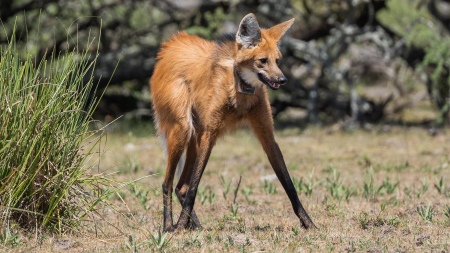A female specimen of maned wow two-year-old returned to its natural habitat in the province of Santa Fe after being rescued and assisted for more than a year and a half through the Rescue and Interpretation Center for Fauna “La Esmeralda”reported this Monday the Ministry of Environment of Santa Fe.
The maned man was found when he was a baby in the rural area of Fortín Olmos in the Bajos Submeridionales, after losing his mother, and after staying in that institution, belonging to the Ministry of Environment and Climate Change in Santa Fe, was referred to the Temaikén Species Recovery Center (CRET) de Escobar in Buenos Aires to complete his behavioral rehabilitation.
As detailed in a press release, with medical and behavioral discharge after months of successful development and learning, the specimen of maned guazú returned to the area of the Saladillo Dulce and Amargo streams in the department of San Javier, in the north of Santa Faith.

In Argentina, the maned maned man is “threatened mainly by human action” through the loss and/or degradation of their optimal habitats, road kills, direct persecution, capture, and illegal hunting, since “little knowledge about the species surrounds it with myths and misinformation.”
And they exemplified that, with this species, there is a belief that “it feeds on livestock or is dangerous to people, when its main diet includes fish, small rodents, birds, reptiles and fruits. With humans it is elusive and harmless“.
“The main tasks that were carried out consisted of an evaluation of its state of health at the time of admission, taking various biological samples and the design of a plan so that the animal can go through the time of captivity in the best way” commented Pablo Siroski , veterinarian at the Fauna Rescue and Interpretation Center.

The behavioral rehabilitation carried out at the Temaikén Foundation was the final stretch of the management stage under human care.
This instance, where the animal is monitored through trap cameras to avoid contact with people and to become familiar with the human being, consists of helping it to recover or acquire from the beginning the skills and behaviors of its species that are necessary for it to can survive in nature.
This maned man was reinserted with a transmitter that will allow obtaining valuable information for the conservation of the species.

In this way, Temaikèn specialists will be able to follow their movements, find out their area of distribution and distances traveled, as well as being able to infer, with information from the environment, more about their habits and state of health.
“For us it is essential to know if the health and behavioral rehabilitation was successful and to see where it moves in nature. The collar has a battery that lasts approximately 18 months and allows you to program a date when the device automatically detaches from the animal’s collar.”indicated Paula González Ciccia, director of Conservation, Education and research at the Temaikèn Foundation.
The information provided by the transmitter is added to that obtained from other maned maned specimens that underwent this same process and is analyzed together with collaborators from the Austral Center for Scientific Research (Cadic-Conicet) Ushuaia, the National Institute of Limnology, Conicet, Santa Fe, and the Institute of Ecology, Genetics and Evolution of Buenos Aires-Conicet, Faculty of Exact and Natural Sciences of the University of Buenos Aires.
The maned guazú (name that means “big fox” in Guarani) is a mammal of the canid family (a group to which foxes and dogs also belong) endemic to South America, which inhabits open flooded areas between grasslands and islets of mount and palm groves
In Argentina, its distribution covers the provinces of Corrientes, Formosa, Chaco, north of Santa Fe and Córdoba and east of Santiago del Estero.
It is characterized by its long legs and long red fur with a kind of dark mane on its head.
These efforts are also part of an international collaboration through the AZA (American Association of Zoos and Aquariums) SAFE (Saving Animals from Extinction) Program, coordinated by the Temaikén Foundation and the Zoo Conservation Outreach Group.


















